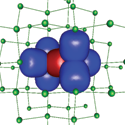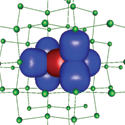Low-cost calculations enrich research
Density functional theory [1] defines a broad framework that has enabled much progress in understanding the electronic structure and properties of matter. In all of the many implementations of this theory [2], it has been a challenge to incorporate the effects of electron exchange and correlation. The manner in which this is accomplished defines an approximation to the unknown density functional. Many approximations are not accurate enough to describe tightly bound electronic states, yet sufficiently accurate schemes come at a forbidding computational cost, placing some research out of reach.
Writing in Physical Review B, Xifan Wu, Annabella Selloni, and Roberto Car from Princeton University develop a hybrid-functional method that both determines the electronic structures of insulators with high accuracy and scales linearly with system size. The thrifty plane-wave scheme employs maximally localized electron wave functions (Wannier functions) in real space, which allows the efficient evaluation of Coulomb integrals. The key is that, as physical intuition suggests, in real space most orbitals overlap significantly only with their close neighbors.
The authors calculate the diamond structure of silicon to test their scheme versus a comparable but more costly exact-exchange method, and obtain essentially identical results. They also demonstrate its efficacy in ab initio molecular dynamics simulations of large supercells with as many as 216 atoms. This methodological advance should be particularly significant for the study of liquids and other disordered systems, which require large supercells to capture their physics. – Matthew Eager
[1] For an introduction and historical review, see the complementary 1998 Nobel Prize lectures by Walter Kohn, Rev. Mod. Phys. 71, 1253 (1999), and John A. Pople, Rev. Mod. Phys. 71, 1267 (1999).
[2] A handy summary is found in J. Hafner, C. Wolverton, and G. Ceder, MRS Bulletin, 31 (9) 659 (2006).





